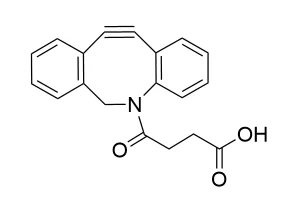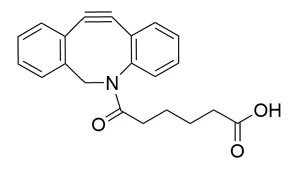Vector Laboratories is closed for the President’s Day on Monday, February 19th. We will be back in the office on Tuesday, February 20th.
We will respond to emails upon our return. Have a wonderful day.
Menu
Vector Laboratories is closed for the President’s Day on Monday, February 19th. We will be back in the office on Tuesday, February 20th.
We will respond to emails upon our return. Have a wonderful day.
Fmoc-N-amido-dPEG®12-acid, product number QBD-10283, is one of a broad line of products designed for use in peptide synthesis. The medium-length (40 atoms), discrete PEG (dPEG®) spacer is functionalized with a propionic acid group on one end and Fmoc-protected amine on the other. The compound can be added to the N-terminus of a growing peptide chain or to a primary-amine-functionalized side chain of an amino acid such as lysine. The dPEG®12 spacer imparts water solubility to the peptide to which it is conjugated.
QBD-10283 permits our customers to insert a medium-length (40 atoms) dPEG® into a peptide chain using familiar Fmoc chemistry. The product works equally well in solid phase and solution phase synthetic processes. The dPEG® can be inserted at either end of the peptide chain or in the middle of two amino acid sequences to provide a flexible spacer between distinct functional peptides. Additionally, the dPEG® spacer can be used to provide spacing in a synthetic construct where steric hindrance is a problem. The amphiphilic nature of dPEG® means that the construct will gain water solubility while remaining soluble in organic solvent. The Fmoc protecting group removes easily with a solution of piperidine in N,N-dimethylformamide (DMF).
| Unit Size | 100 mg, 1000 mg |
|---|---|
| Molecular Weight | 839.96; single compound |
| Chemical formula | C₄₂H₆₅NO₁₆ |
| CAS | 756526-01-9 |
| Purity | > 98% |
| Spacers | dPEG® Spacer is 40 atoms and 46.5 Å |
| Shipping | Ambient |
| Typical solubility properties (for additional information contact Customer Support) | Methylene chloride, Acetontrile, DMAC or DMSO. |
| Storage and handling | -20°C; Always let come to room temperature before opening; be careful to limit exposure to moisture and restore under an inert atmosphere; stock solutions can be prepared with dry solvent and kept for several days (freeze when not in use). dPEG® pegylation compounds are generally hygroscopic and should be treated as such. This will be less noticeable with liquids, but the solids will become tacky and difficult to manipulate, if care is not taken to minimize air exposure. |
Greg T. Hermanson, Bioconjugate Techniques, 3rd Edition, Elsevier, Waltham, MA 02451, 2013, ISBN 978-0-12-382239-0; See Chapter 18, Discrete PEG Reagents, pp. 787-821, for a full overview of the dPEG® products.
Optimization of Xenon Biosensors for Detection of Protein Interactions. Thomas J. Lowery, Sandra Garcia, Lana Chavez, E. Janette Ruiz, Tom Wu, Thierry Brotin, Jean-Pierre Dutasta, David S. King, Peter G. Schultz, Alex Pines, and David E. Wemmer. ChemBioChem. 2006, 7 (1), pp 65-73. January 9, 2006. DOI: 10.1002/cbic.200500327.
Monodispersed DOTA-PEG-Conjugated Anti-TAG-72 Diabody Has Low Kidney Uptake and High Tumor-to-Blood Ratios FResulting in Improved Cu PET. Lin Li, Fabio Turatti, Desiree Crow, James R. Bading, Anne-Line Anderson, Erasmus Poku, Paul J. Yazaki, Lawrence E. Williams, Debra Tamvakis, Paul Sanders, David Leong, Andrew Raubitschek, peter J. Hudson, David Colcher, and John E. Shively. Journal of Nuclear Medicine. 2010, 51 (7), pp 1139-1146. June 16, 2010. DOI: 10.2967/jnumed.109.074153.
Photocleavable Peptide-Conjugated Magnetic Beads for Protein Kinase Assays by MALDI-TOF. MS. Guangchang Zhou, Xiaoliang Yan, Ding Wu, and Stephen J. Kron. Bioconjugate Chemistry. 2010, 21 (10), pp 1917–1924. September 22, 2010. DOI: 10.1021/bc1003058.
Neutrophil Targeting Heterobivalent SPECT Imaging Probe: cFLFLF-PEG-TKPPR-99mTc. Yi Zhang, Li Xiao, Mahendra D. Chordia, Landon W. Locke, Mark B. Williams, Stuart S. Berr, and Dongfeng Pan. Bioconjugate Chemistry. 2010, 21 (10), pp 1788–1793 September 15, 2010. DOI: 10.1021/bc100063a.
Calcium Condensed LABL-TAT Complexes Effectively Target Gene Delivery to ICAM-1 Expressing Cells. Supang Khondee, Abdulgader Baoum, Teruna J. Siahaan, and Cory Berkland. Molecular Pharmaceutics. 2011, 8 (3), pp 788–798. April 7, 2011. DOI: 10.1021/mp100393j.
Site-Specific Conjugation of Monodispersed DOTA-PEGn to a Thiolated Diabody Reveals the Effect of Increasing PEG Size on Kidney Clearance and Tumor Uptake with Improved 64-Copper PET Imaging. Lin Li,Desiree Crow, Fabio Turatti, James R. Bading, Anne-Line Anderson, Erasmus Poku, Paul J. Yazaki, Jenny Carmichael, David Leong, Michael P. Wheatcroft,Andrew A. Raubitschek, Peter J. Hudson,David Colcher, and John E. Shively. Bioconjugate Chemistry. 2011, 22 (4), pp 709–716. March 12, 2011. DOI: 10.1021/bc100464e.
Flexible antibodies with nonprotein hinges. Daniel J. Capon, Naoki Kaneko, Takayuki Yoshimori, Takashi Shimada, Florian M. Wurm, Peter K. Hwang, Xiaohe Tong, Staci A. Adams, Graham Simmons, Taka-Aki Sato and Koichi Tanaka. The Japan Academy Series B Physical and Biological Sciences. 2011, 87 (9), pp 603-616. November 11, 2011. DOI: 10.2183/pjab.87.603.
Enhanced Cellular Uptake of Peptide-Targeted Nanoparticles through Increased Peptide Hydrophilicity and Optimized Ethylene Glycol Peptide-Linker Length. Jared F. Stefanick, Jonathan D. Ashley, and Basar Bilgicer. ACS Nano. 2013, 7 (9) pp 8115-8127. August 29, 2013. DOI: 10.1021/nn4033954.
A Systematic Analysis of Peptide Linker Length and Liposomal Polyethylene Glycol Coating on Cellular Uptake of Peptide-Targeted Liposomes. Jared F. Stefanick, Jonathan D. Ashley, Tanyel Kiziltepe, and Basar Bilgicer. ACS Nano. 2013, 7 (4) pp 2935–2947. February 19, 2013. DOI: 10.1021/nn305663e.
Enhanced Cellular Uptake of Peptide-Targeted Nanoparticles through Increased Peptide Hydrophilicity and Optimized Ethylene Glycol Peptide-Linker Length. Jared F. Stefanick, Jonathan D. Ashley, and Basar Bilgicer. ACS Nano. 2013, 7 (9) pp 8115–8127. August 29, 2013. DOI: 10.1021/nn4033954.
Oriented Surface Immobilization of Antibodies at the Conserved Nucleotide Binding Site for Enhanced Antigen Detection. Nathan J Alves, Tanyel Kiziltepe, and Basar Bilgicer. Langmuir. 2012, 28 (25) pp 9640–9648. May 21, 2012. DOI: 10.1021/la301887s.
Hepatocyte Targeting of Nucleic Acid Complexes and Liposomes by a T7 Phage p17 Peptide. So C. Wong, Darren Wakefield, Jason Klein, Sean D. Monahan, David B. Rozema, David L. Lewis, Lori Higgs, James Ludtke, Alex V. Sokoloff, and Jon A. Wolff. Molecular Pharmaceutics. 2006, 3 (4) pp 386-397. March 28, 2006. DOI: 10.1021/mp050108r.
Evaluation of Nonpeptidic Ligand Conjugates for SPECT Imaging of Hypoxic and Carbonic Anhydrase IX-Expressing Cancers. Peng-Cheng Lv, Karson S. Putt, and Philip S. Low. Bioconjugate Chemistry. 2016, 27, pp 1762-1769. June 30, 2016. DOI: 10.1021/acs.bioconjchem.6b00271.
Synthesis of the Cyanine 7 labeled neutrophil-specific agents for noninvasive near infrared fluorescence imaging. Xiao L, Zhang Y, Liu Z, Yang M, Pu L, Pan D. Bioorganic & Medicinal Chemistry Letters. 2010, 20 (12) pp 3515-3517. June 15, 2010. DOI: 10.1016/j.bmcl.2010.04.136.
PEG-Peptide Conjugates. Ian W Hamley. Biomacromolecules. 2014, 15 (5) pp 1543-1559. April 1, 2014. DOI: 10.1021/bm500246w.
Controlled liposome fusion mediated by SNARE protein mimics. Hana Robson Marsden, Alexander V. Korobko,Tingting Zheng, Jens Voskuhla and Alexander Kros. Biomaterials Science. 2013, 1 (10) pp 1046-1054. June 4, 2013. DOI: 10.1039/C3BM60040H.
SNARE protein analog-mediated membrane fusion. Pawan Kumar, Samit Guha and Ulf Diederichsen. Journal of Peptide Science. 2015, April 7, 2015. DOI: 10.1002/psc.2773.
In Situ Modification of Plain Liposomes with Lipidated Coiled Coil Forming Peptides Induces Membrane Fusion. Frank Versluis , Jens Voskuhl , Bartjan van Kolck , Harshal Zope , Marien Bremmer , Tjerk Albregtse and Alexander Kros. Journal of the American Chemical Society. 2013, 135 (21), pp 8057–8062. May 9, 2013. DOI: 10.1021/ja4031227.
A Reduced SNARE Model for Membrane Fusion. Hana Robson Marsden, Nina A. Elbers, Paul H., H. Bomans, Nico A.J.M.Sommerdijk and Alexander Kros. Communications. 2009, 48 pp 2330-2333. February 16, 2009. DOI: 10.1002/anie.200804493.
Insights into the role of sulfated glycans in cancer cell adhesion and migration through use of branched peptide probe. Jlenia Brunetti, Lorenzo Depau, Chiara Falciani, Mariangela Gentile, Elisabetta Mandarini, Giulia Riolo, Pietro Lupetti, Alessandro Pini, and Luisa Bracci. Scientific Reports. 2016, 6 (27174). June 3, 2016. DOI: 10.1038/srep27174.
Bioresponsive nanocarries for targeted intracellular delivery of proteins and peptides. Ruth Elisabeth and Johanna Roder. Dissertation zur Erlangung des Doktorgrades der Fakultat fur Chemie und Pharmazie der Ludwig-Maximilians-Universitat Munchen. 2016, pp 1-128.
Bioresponsive nanocarries for targeted intracellular delivery of proteins and peptides. Ruth Elisabeth and Johanna Roder. Dissertation zur Erlangung des Doktorgrades der Fakultat fur Chemie und Pharmazie der Ludwig-Maximilians-Universitat Munchen. 2016, pp 1-128.
Influence of Defined Hydrophilic Blocks within Oligoaminoamide Copolymers: Compaction versus Sheilding of pDNA Nanoparticles. Stephan Morys, Ana Krhac Levacic, Sarah Urnauer, Susanne Kempter, Sarah Kern, Joachim O Radler, Christine Spitzweg, Ulrich Lachelt, and Ernst Wagner. Polymers. 2017, 9 (4) pp 1-20. April 19, 2017. DOI: 10.3390/polym9040142.
Control of strand registry by attachment of PEG chains to amyloid peptides influences nanostructure. Valeria Castelletto, Ge Cheng, Steve Furzeland, Derek Atkinsb and Ian W. Hamley. Soft matter. 2012, 8, pp 5434-5438. April 16, 2012. DOI:10.1039/C2SM25546D.
Morphological Transformation of Peptide Nanoassemblies through Conformational Transition of Core-forming Peptides. Tomonori Waku, Naoyuki Hirata, Masamichi Nozaki, Kanta Nogami, Shigeru Kunugi and Naoki Tanaka. Polymers. 2018, 11 (1), 39. December 28, 2018. https://doi.org/10.3390/polym11010039
Membrane-Fusogen Distance Is Critical for Efficient Coiled-Coil-Peptide-Mediated Liposome Fusion. Geert A. Daudey, Harshal R. Zope, Jens Voskuhl, Alexander Kros , and Aimee L. Boyle. Langmuir. 2017, 33 (43) pp 12443-12452. 10/5/2017. DOI: 10.1021/acs.langmuir.7b02931.
Use of a leukocyte-targeted peptide probe as a potential tracer for imaging the tuberculosis granuloma. Landon W. Locke, Shankaran Kothandaraman, Michael Tweedle, Sarah Chaney, Daniel J. Wozniak, and Larry S. Schlesinger. Tuberculosis. 2018, 108 pp 201-210. January 8, 2018. DOI: 10.1016/j.tube.2018.01.001.
Coiled-coil formation of the membrane-fusion K/E peptides viewed by electron paramagnetic resonance. Pravin Kumar, Martin van Son, Tingting Zheng, Dayenne Valdink, Jan Raap, Alexander Kros, and Martina Huber. PLOS ONE. 2018, 13 (1) pp 1-13. January 19, 2018. DOI: 10.1371/journal.pone.0191197.
Near-infrared quantum dots labelled with a tumor selective tetrabranched peptide for in vivo imaging. Jlenia Brunetti, Giulia Riolo, Mariangela Gentile, Andrea Bernini, Eugenio Paccagnini, Chiara Falciani, Luisa Lozzi, Silvia Scali, Lorenzo Depau, Alessandro Pini, Pietro Lupetti, and Luisa Bracci. Journal of Nanobiotechnology. 2018, 16 (21) pp. 1-10. March 3, 2018. DOI: 10.1186/s12951-018-0346-1.
Targeted Polymer-Based Probes for Fluorescence Guided Visualization and Potential Surgery of EGFR-Positive Head-and-Neck Tumors. Robert Pola ,Eliška Böhmová ,Marcela Filipová,Michal Pechar,Jan Pankrác, David Větvička, Tomáš Olejár, Martina Kabešová, Pavla Poučková, Luděk Šefc, Michal Zábrodský, Olga Janoušková, Jan Bouček, and Tomáš Etrych. Pharmaceutics 2020, 12(1), 31; January 1, 2020. https://doi.org/10.3390/pharmaceutics12010031
Polymer Cancerostatics Containing Cell-Penetrating Peptides: Internalization Efficacy Depends on Peptide Type and Spacer Length. Eliška Böhmová ,Robert Pola, Michal Pechar, Jozef Parnica, Daniela Machová, Olga Janoušková and Tomáš Etrych. Pharmaceutics 2020, 12(1), 59; January 10, 2020. https://doi.org/10.3390/pharmaceutics12010059
A Novel Bivalent Mannosylated Targeting Ligand Displayed on Nanoparticles Selectively Targets Anti-Inflammatory M2 Macrophages. Peiming Chen, Xiaoping Zhang, Alessandro Venosa, In Heon Lee, Daniel Myers, Jennifer A. Holloway, Robert K. Prud’homme, Dayuan Gao, Zoltan Szekely, Jeffery D. Laskin, Debra L. Laskin, and Patrick J. Sinko. Pharmaceutics 2020, 12(3), 243. March 8, 2020. DOI: 10.3390/pharmaceutics12030243
A New NT4 Peptide-Based Drug Delivery System for Cancer Treatment. Jlenia Brunetti, Sara Piantini, Marco Fragai, Silvia Scali, Giulia Cipriani, Lorenzo Depau, Alessandro Pini, Chiara Falciani, Stefano Menichetti and Luisa Bracci. Molecules 2020, 25(5), 1088; February 28, 2020. DOI: 10.3390/molecules25051088
Efficient capture of circulating tumor cells with low molecular weight folate receptor-specific ligands. Yingwen Hu, Danyang Chen, John V Napoleon, Madduri Srinivasarao, Sunil Singhal, Cagri A Savran, Philip S Low. Scientific Reports. 2022. May 20, 2022. https://doi.org/10.1038/s41598-022-12118-3
Applicable patents and legal notices are available at legal notices.




Stay in the Loop. Join Our Online Community
Together we breakthroughTM

©Vector Laboratories, Inc. 2024 All Rights Reserved.
How do I Request a Quote?
To request a quote for products: